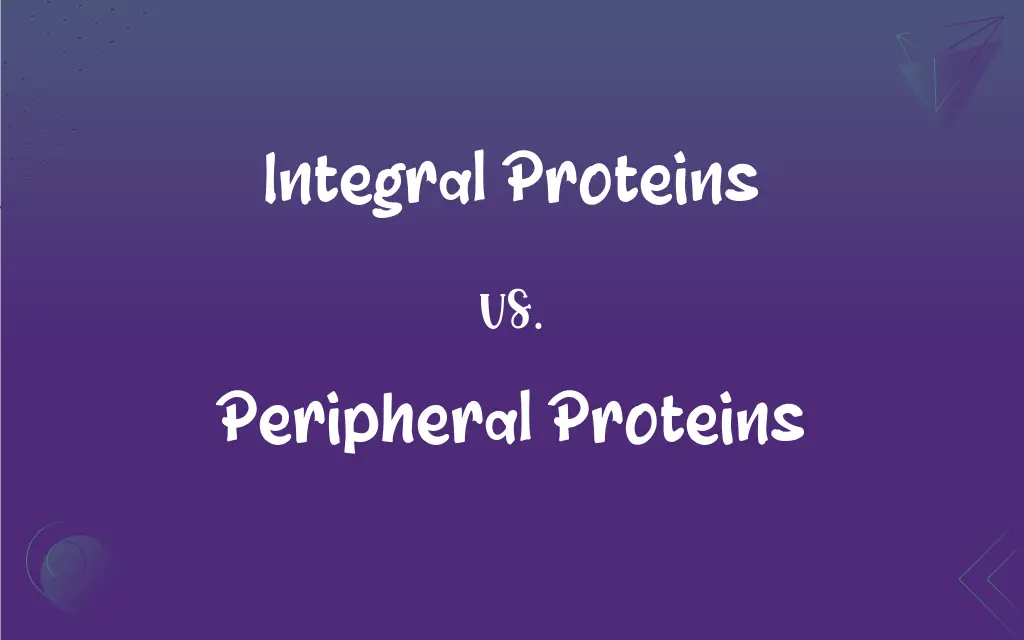Integral Proteins vs. Peripheral Proteins: What's the Difference?
Edited by Janet White || By Harlon Moss || Published on January 3, 2024
Integral proteins are embedded within the cell membrane, while peripheral proteins are attached loosely to the membrane's exterior or to integral proteins.

Key Differences
Integral proteins are embedded within the phospholipid bilayer of cell membranes, often spanning the entire membrane. Peripheral proteins, on the other hand, are not embedded but rather are attached loosely to the membrane's surface or to integral proteins.
Integral proteins play key roles in transporting substances across the membrane and in cell signaling, due to their position within the membrane. Peripheral proteins, however, are more involved in functions like signal transduction and maintaining the cell's shape, as they are on the membrane's periphery.
Removing integral proteins from the membrane usually requires disrupting the membrane structure, as they are firmly anchored. Peripheral proteins can be detached more easily without disturbing the membrane's integrity, reflecting their more temporary association.
Integral proteins are often glycoproteins, playing a role in cell recognition and adhesion. Peripheral proteins, though they can also be glycoproteins, are more varied in function, including acting as enzymes or structural components of the cytoskeleton.
The structure of integral proteins allows them to interact with both the internal and external environments of the cell. In contrast, peripheral proteins typically interact with either the cell's exterior environment or the cytoplasmic side, but not both.
ADVERTISEMENT
Comparison Chart
Location in Cell Membrane
Embedded within the membrane
Attached to the membrane's surface
Role
Transport, cell signaling
Signal transduction, maintaining cell shape
Interaction with Cell Environments
Both internal and external environments
Typically one side of the membrane
Removal from Membrane
Requires membrane disruption
Can be detached more easily
Functions and Characteristics
Often glycoproteins, span membrane
Varied, often enzymes or structural components
ADVERTISEMENT
Integral Proteins and Peripheral Proteins Definitions
Integral Proteins
Proteins that are permanently attached to the cell membrane.
The integral protein is crucial for transporting glucose into the cell.
Peripheral Proteins
Proteins that can be easily removed from the cell membrane.
Enzymes attached as peripheral proteins assist in metabolic processes.
Integral Proteins
Proteins that form pores or channels in the cell membrane.
Water channels in the kidney cells are made of integral proteins.
Peripheral Proteins
Membrane proteins not embedded in the lipid bilayer.
Certain peripheral proteins act as temporary receptors for molecules.
Integral Proteins
Proteins that are embedded within the cell membrane.
The integral protein acted as a channel for ions to pass through the membrane.
Peripheral Proteins
Proteins attached to the exterior of the cell membrane.
A peripheral protein on the cell membrane helps anchor the cytoskeleton.
Integral Proteins
Membrane proteins that span the entire phospholipid bilayer.
This integral protein functions as a receptor for specific molecules.
Peripheral Proteins
Proteins involved in maintaining the cell's shape and structure.
Peripheral proteins contribute to the cell's structural integrity.
Integral Proteins
Components of the cell membrane involved in cell signaling.
Integral proteins in the nerve cells aid in transmitting signals.
Peripheral Proteins
Loosely bound proteins to the surface of the membrane or integral proteins.
This peripheral protein plays a role in cellular communication.
FAQs
Can integral proteins move within the membrane?
Some can move laterally, but they remain embedded within the membrane.
What distinguishes integral from peripheral proteins?
Integral proteins are embedded in the membrane, while peripheral proteins attach to the membrane's surface.
What role do integral proteins play in cell recognition?
As glycoproteins, they are key in cell recognition and adhesion processes.
Do integral proteins have hydrophobic regions?
Yes, which allows them to be embedded within the hydrophobic core of the membrane.
Are peripheral proteins always present on the cell surface?
They are either on the external or internal side of the membrane, but not spanning it.
Are all peripheral proteins enzymes?
No, they have diverse functions including but not limited to enzymatic activity.
Do peripheral proteins interact with the cell's interior?
Yes, some interact with the cytoplasmic side of the membrane.
How are integral proteins important in cellular functions?
They are crucial for transport, cell signaling, and intercellular interactions.
Can peripheral proteins function as enzymes?
Yes, many act as enzymes involved in various cellular processes.
Is it easy to separate peripheral proteins from the membrane?
Yes, they can often be detached without disrupting the membrane.
Are integral proteins involved in cell adhesion?
Yes, some integral proteins play roles in cell-cell adhesion processes.
Can peripheral proteins be part of cell signaling pathways?
Absolutely, they often participate in signal transduction mechanisms.
Can peripheral proteins be found inside the cell?
Yes, they can be attached to internal structures like the cytoskeleton.
Can integral proteins transport ions?
Yes, many function as ion channels or transporters.
Do integral proteins have specific orientations in the membrane?
Yes, they are oriented based on their functions and interactions.
Do changes in pH affect peripheral proteins?
Yes, pH changes can alter their binding to the membrane.
How are integral proteins inserted into the membrane?
They are typically integrated during the process of membrane synthesis.
How are peripheral proteins attached to integral proteins?
Through non-covalent interactions such as ionic bonds or hydrogen bonds.
Do peripheral proteins change the membrane's fluidity?
They generally don't significantly affect the membrane's fluidity.
Can integral proteins act as receptors?
Yes, many serve as receptors for various molecules, including hormones.
About Author
Written by
Harlon MossHarlon is a seasoned quality moderator and accomplished content writer for Difference Wiki. An alumnus of the prestigious University of California, he earned his degree in Computer Science. Leveraging his academic background, Harlon brings a meticulous and informed perspective to his work, ensuring content accuracy and excellence.
Edited by
Janet WhiteJanet White has been an esteemed writer and blogger for Difference Wiki. Holding a Master's degree in Science and Medical Journalism from the prestigious Boston University, she has consistently demonstrated her expertise and passion for her field. When she's not immersed in her work, Janet relishes her time exercising, delving into a good book, and cherishing moments with friends and family.






































































